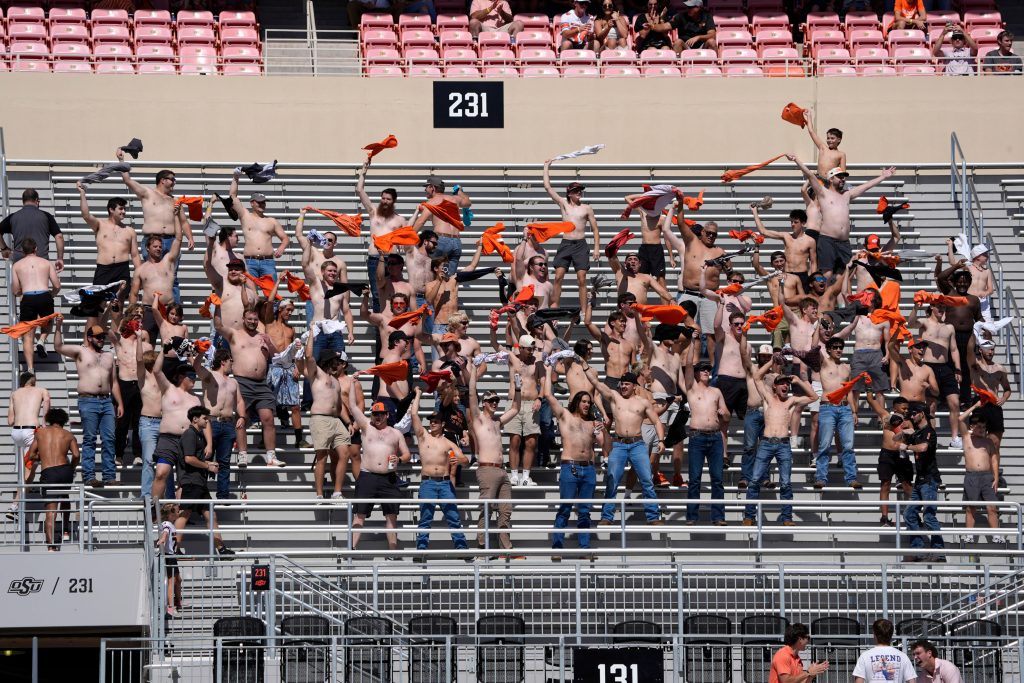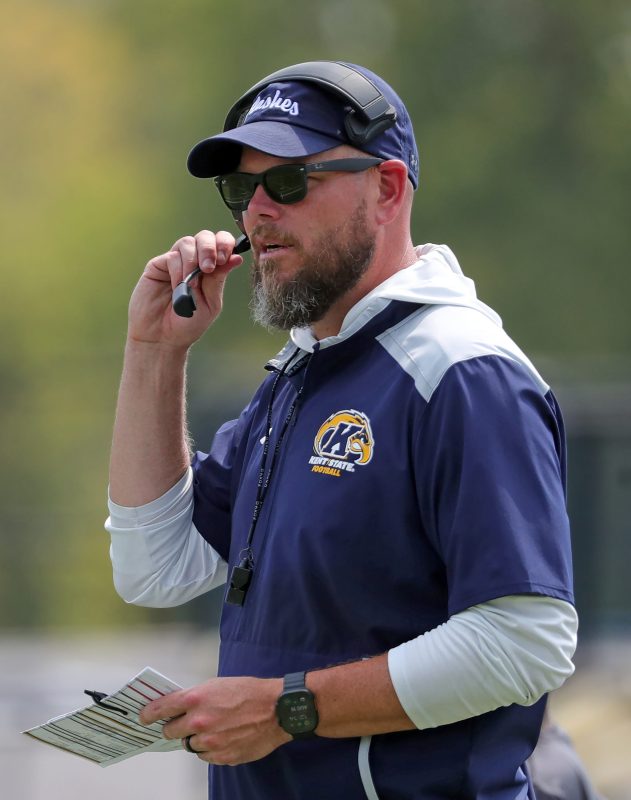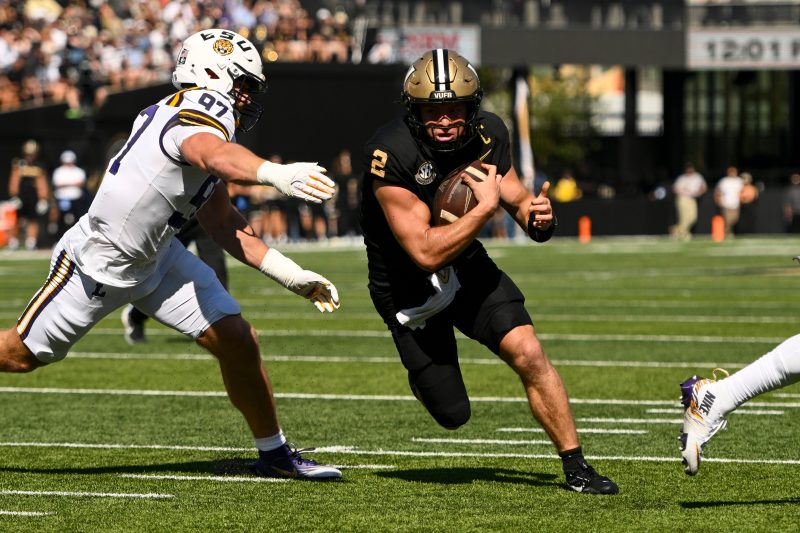How a bet started a college football trend of shirtless fans

- A trend of fans taking off their shirts and waving them in the air has spread across college football.
- The movement began when an Oklahoma State fan was dared by his sister to wave his shirt in an empty section of the stadium.
- The trend has served as reminder for people to have fun at college football games, regardless of the result.
Viruses are terrifying. Once it finds a host, it can spread rapidly and infecting all victims anywhere in its path.
There’s a new virus spreading through college football. In just a few weeks, it’s gone from one stadium to stretching across the country, contaminating nearly every cathedral that houses the sport. The symptoms?
Fans taking off their shirts and waving them in the air in the masses.
Like most infectious diseases, it can be traced to a starting point. A dare between siblings on Oct. 11 in Stillwater, Oklahoma, led to its birth. In a matter of weeks, it’s taken over college football to produce one of the most mesmerizing sights to behold.
“It’s not what you expected to happen,” Trent Eaton told USA TODAY Sports.
Is it really an illness? No, even if it appears to be making people mad.
Is it bad? Far from it, as it has reminded those that started it what college football is all about: having fun.
How viral Oklahoma State trend began
It’s no secret 2025 has been a bad one for Oklahoma State. Entering that Oct. 11 afternoon, the Cowboys were 1-4 and had fired longtime coach Mike Gundy. Oklahoma State student Luke Schneberger recalled the vibes inside Boone Pickens Stadium “were just not there.”
Through three quarters against Houston, the Cowboys were down 36-10 and headed toward a fifth consecutive loss. The stadium was emptying when Eaton, a lifelong Cowboys fan, was dared by his sister Callista Bradford, a season ticket holder, to go to a lifeless section, take off his shirt and wave it for $10.
Not ashamed, Eaton walked around the stadium to section 231 and by himself, waved his shirt for the crowd to see. Patient No. 0.
It takes more than one for a virus to thrive. Luckily, Schneberger’s friends saw Eaton on the jumbotron. They said he should go join him. Schneberger thought it was a good idea.
So, Schneberger walked up to section 231. He and Eaton didn’t know each other, but only a few words were said to connect them.
“Hey man. Mind if I join you?” Schneberger said.
“Yeah, c’mon,” Eaton responded.
Patient No. 1. The two strangers stood together, laughing and waving their shirts as the sun beamed on their torsos. While attempting to boost the mood, neither weren’t sure how long they would last.
Call it dramatic or silly, but it can get pretty tiring swinging your arm. Eaton said he had enough juice until the end of the third quarter, while Schneberger didn’t know how long he could go.
That’s when a group of guys walked by and Schneberger encouraged them to join. They did, and the group grew.
Before they realized it, the entire section and nearby ones were filled with guys enthusiastically waving their shirts.
“I didn’t expect as many people as ended up coming up to happen,” Eaton said.
Call it an outbreak.
The scene went viral as Oklahoma State and college football fans watched in amazement of the “tarps off” scene. There is no real way to describe it other than just guys being dudes.
“If you looked up guys being dudes in the dictionary, the tarps off sections would probably be in there,” Schneberger said.
Waving shirts spread
Eaton became an instant celebrity in Stillwater, taking photos with admirers when he and his sister went to get food after the game. While it was a cool moment that brought joy to a miserable fan base, Eaton and Bradford figured it would be a one game thing.
That was until later in the week when someone sent Bradford a video from a local high school volleyball game, where a group of boys replicated her brother.
The movement spread out of Boone Pickens Stadium. Next thing they knew, it found its way to other college football stadiums. One week later, it was done at Wisconsin’s Camp Randall Stadium. Also at the Rose Bowl for UCLA’s home game.
A week later, the virus continued to grow to Virginia Tech, North Carolina and several others. It even made its way to Eugene, Oregon, where even the Oregon Duck mascot did it. Section 231 at Oklahoma State became known as 2-no shirty-1.
“I saw videos all across the states of several college teams doing it,” Bradford said. “I was like, ‘oh man, we started a trend.’”
Why has shirtless movement become popular?
Other than believing it’s some viral infection, there’s no way to explain why this trend has caught on.
“It was just shocking to me how fast it spread,” Schneberger said. “Something that I was a small part in getting that big is just very surreal for me.”
Eaton wasn’t the first person to ever wave their shirt at a sporting event, but it has clearly resonated. He pointed to where this movement took shape. Oklahoma State is in the midst of a struggling season. So are UCLA, Wisconsin and North Carolina. It became a big thing by the time it caught on to good teams like Oregon.
“Most fans realize that their team’s not always going to be great, but they can still go support them and have fun and make something out of not a great season,” Eaton said.
Schneberger agreed, adding that fans can’t just feel down the entire time and make some fun in even the worst situations. Even though Oklahoma State lost that Houston game by 22 points, it brought some joy to campus. Bradford also noted going to games is about more than the result; the atmosphere and fun are what makes the experience so unique.
“It’s that perfect recipe for it to be for college football,” Schneberger said. “It’s such a fun thing to do. Just get up there with your buddies and, you know, swing your shirt around.”
There’s no telling how long this virus will last. Eaton and Bradford have both been invited back for Oklahoma State’s next home game on Nov. 15 to be recognized, where the shirtless fun can very well continue in Stillwater. We will also have to see if the virus can survive the winter conditions that are on the horizon for the rest of the country.
“You’re not always on top,” Bradford said. “But you can also always have a good time.”







